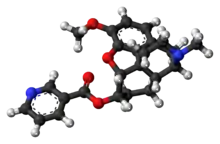Nicodicodine
Nicodicodine is an opioid developed as a cough suppressant and analgesic.[7] Synthesized in 1904, it is not commonly used, but has activity similar to other opioids.[7] Nicodicodine is metabolised in the liver by demethylation to produce 6-nicotinoyldihydromorphine, and subsequently further metabolised to dihydromorphine. Since the final active metabolite is the slightly stronger opiate dihydromorphine rather than morphine, nicodicodine can be expected to be marginally more potent and longer acting than nicocodeine. Side effects are similar to those of other opioids and include itching, nausea and respiratory depression.
 | |
 | |
| Clinical data | |
|---|---|
| Other names | Nicodicodeine, 6-Nicotinoyldihydrocodeine, Nicodicodina,[1] Nicodicodinum[1] |
| Routes of administration | Oral, intravenous |
| ATC code |
|
| Legal status | |
| Legal status | |
| Identifiers | |
IUPAC name
| |
| CAS Number | |
| PubChem CID | |
| ChemSpider | |
| UNII | |
| CompTox Dashboard (EPA) | |
| ECHA InfoCard | 100.011.241 |
| Chemical and physical data | |
| Formula | C24H26N2O4 |
| Molar mass | 406.482 g·mol−1 |
| 3D model (JSmol) | |
SMILES
| |
InChI
| |
| | |
References
- "Nicodicodine [INN:BAN:DCF] | SIELC". www.sielc.com. 16 May 2018. Retrieved 12 January 2019.
- "Drugs Misuse Regulation 1987". www.legislation.qld.gov.au. Office of the Queensland Parliamentary Counsel. Retrieved 10 January 2019.
- "Anlage II BtMG - Einzelnorm". www.gesetze-im-internet.de.
- "Misuse of Drugs Act 1971". www.legislation.gov.uk. Retrieved 10 January 2019.
- "The International Drug Control Conventions". undocs.org. United Nations. Retrieved 10 January 2019.
- "Chemistry Dashboard". comptox.epa.gov. U.S. Environmental Protection Agency. Retrieved 10 January 2019.
- Stolberg VB (2016). Painkillers: History, Science, and Issues. ABC-CLIO. p. 110. ISBN 978-1-4408-3532-2. Retrieved 12 January 2019.
This article is issued from Wikipedia. The text is licensed under Creative Commons - Attribution - Sharealike. Additional terms may apply for the media files.